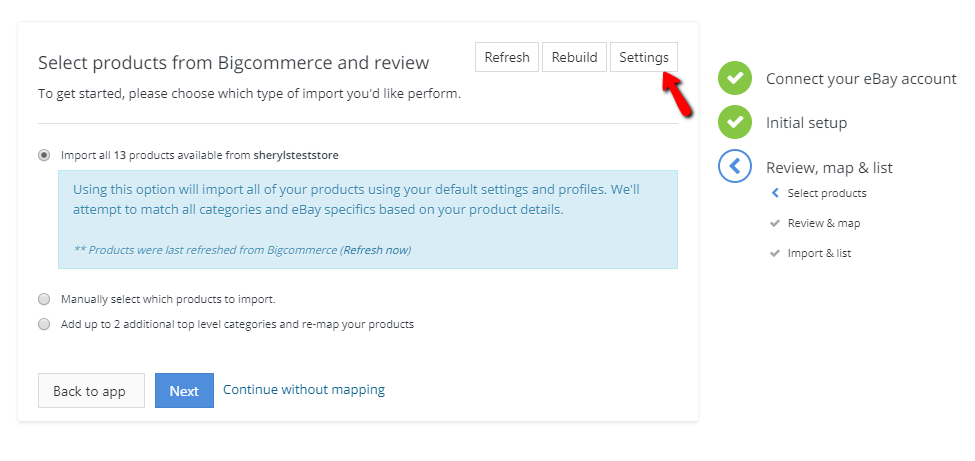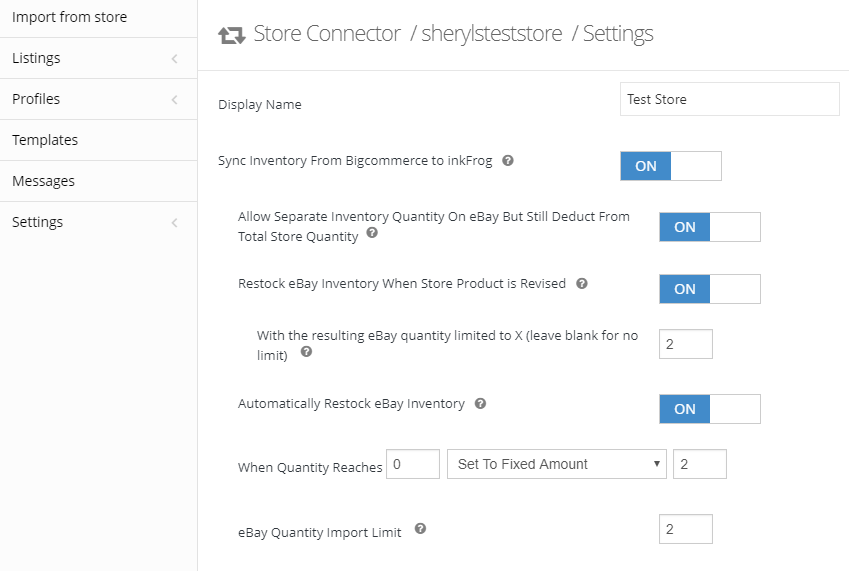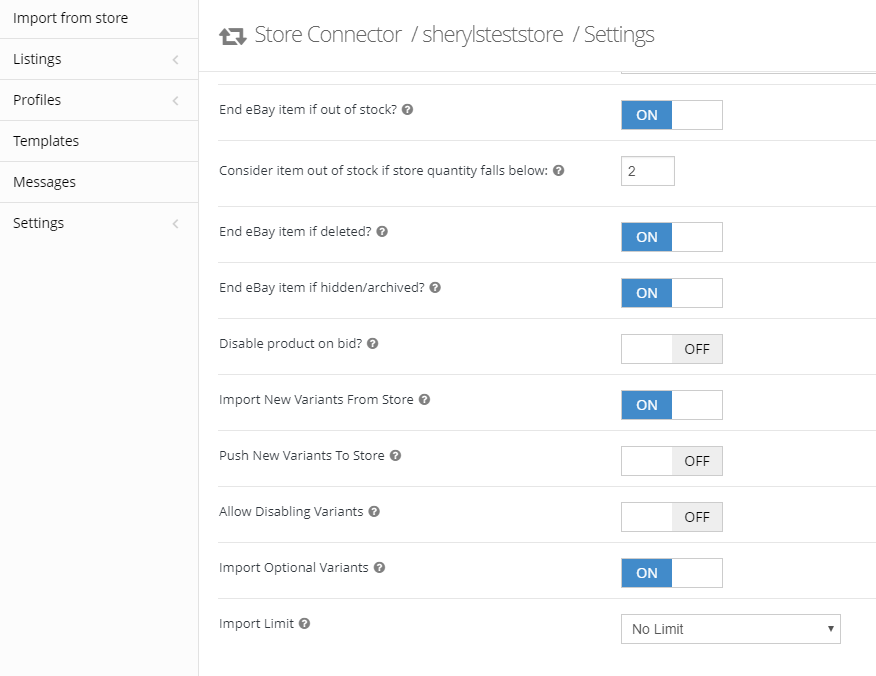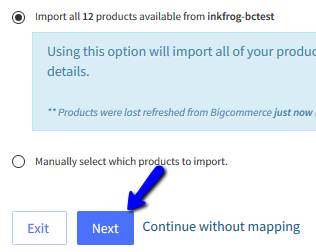The free eBay app lists your BigCommerce catalog’s products in the eBay marketplace and syncs product and order data to and from BigCommerce. It is free to install and use. The app is available to US merchants with USD as their default currency. The app can only be found in Channel Manager and does not appear in the App Marketplace.
Install eBay
Go to Channel Manager and click + Create Channel. Click Connect next to eBay.
In the list of providers, click Connect next to eBay.
Follow the instructions in the integration to connect eBay to your BigCommerce store. Once installed, continue with the instructions below to get it set up.
Default Listing Settings
First, we will be setting up the default listing settings for your eBay listings.
These settings will also create default shipping, payment, and return profiles for your eBay listings.
General
Select your Country, enter your Zip/Postal Code, and your Location (City, State/Province).
Select your eBay Market.
Note: If you intend on selling on eBay Motors, please select eBay Motors as the market here.
Click Continue.
Categories
Select the parent eBay categories that your products will fall under.
Choose all possible top-level eBay categories that the products would use. This ensures that the products will only be placed within those categories. If none are selected we will still attempt to match all of the products, but this will increase the likelihood of some products ending up with the incorrect eBay category. The opportunity to change these category selections is available on the import & list step.
Note: If your BigCommerce products have variations, you will want to review this eBay multi-variation category lookup tool to ensure the top level categories selected support variations - http://pages.ebay.com/sellerinformation/sellingresources/multiplevariationslist.html.
The subcategories are addressed just prior to product import in future steps.
You are able to select 0 to 5 categories, then select Continue.

Payment
Enter your PayPal email address.
Select your Sales Tax settings.
Checkout instructions are not necessary unless there are special circumstances, such as with custom-made products, where there is an extended wait period before the item will be shipped to your customer.
Select Continue.
Shipping
Select your shipping type - flat, calculated, or a combination - depending on whether you ship domestic only, or domestic and internationally.
Select your handling time. The shortest time between receiving payment from your customer until the product in the hands of the shipping carrier. It’s best to be realistic and not over promise on your handling time.
Choose your Domestic Shipping Services. You’re able to select Add additional shipping service if you would like to offer your customers a selection at checkout.
Choose your International Shipping Services. You’re able to select Add additional shipping service if you would like to offer your customers a selection at checkout.
If you do not ship internationally, leave the international setting as is.
Select Continue.
Set up your default Return Policy settings. If you do not accept returns, un-select the returns accepted box.
Select the number of days the item must be returned within. eBay recommends 30 days.
Choose how the refund will be offered, who will pay return shipping, and whether or not you charge a restocking fee.
Add any return policy text.
Note: Do not include any direct contact information within the return policy text such as email, phone number, website URL, or physical address.
Select Finish.
Once Finish is selected, a list of products available to import from your store will begin to build.
When the build of that list is complete, you’re able to import all or manually select which products to import and publish to eBay.
The shipping, payment, and return profiles for eBay may be edited at any time under Profiles.

Sync Settings
Your sync settings determine what information is shared between Bigcommerce and eBay.
To access sync settings, select the settings button and choose sync settings.

Inventory & Order Sync
If you’re tracking your inventory within Bigcommerce (by sku), your inventory and order sync from eBay to BigCommerce is automatic and inventory sync from BigCommerce to eBay may be turned on.
If you are not tracking inventory in BigCommerce, your eBay listings will automatically import with a quantity of 1 available and will auto restock to quantity 1 on eBay each time the product sells on eBay.
eBay orders will automatically be created within BigCommerce for any eBay sold product listing that is linked to a BigCommerce product. The order may be fulfilled within BigCommerce and the order status will automatically update to eBay.
You’re able to offer a lower available quantity of products on eBay than the quantity that you have available on BigCommerce using the Allow Separate Inventory Quantity on eBay setting.
If you enable separate inventory, the options to Restock eBay Inventory as well as Automatically Restock eBay Inventory are offered.
Restock eBay inventory, restocks eBay quantity based on restocking BigCommerce quantity of a product. For example, if you have an eBay quantity of 3 and a BigCommerce quantity of 5, and you increase your BigCommerce quantity to 11, which is an increase of 6, eBay will also be increased by 6 and become quantity 9. If you set a limit here, the eBay restock value will not go above the limit you’ve entered.
When enabled, the auto restock eBay inventory option requires values for “When (eBay) Quantity Reaches ___ Set to Fixed Amount ___".
If you enter when quantity reaches 1 set to a fixed amount of 2, when eBay quantity of a product reaches 1 due to a sale on eBay, eBay will be automatically restocked to quantity 2 as long as 2 or more are available on BigCommerce and according to your overall sync settings that are enabled.
If you choose to use the eBay Quantity Import Limit, when you import products from BigCommerce, the eBay quantity will automatically be set to this amount as long as the BigCommerce quantity value is at or below this amount. If this field is left blank, the full BigCommerce quantity value will import.

Title, Description, & Price Sync
You’re also able to sync Title, Description, and Pricing between eBay and BigCommerce. If you intend on making any changes to the product title, description, or pricing for your eBay listings, we recommend turning off these sync settings both ways.
You’re also able to share sale pricing from BigCommerce to eBay or eBay to BigCommerce. As well as increase or decrease the pricing for eBay with the Set eBay price to sync setting.
In this example, we’ve set the price sync to increase eBay 20% above BigCommerce pricing for all imported products by setting the value to 120% of the store price.
To increase pricing, please be sure to set it above 100% of the BigCommerce pricing, if we had set 20% in this field, then eBay would be priced at only 20% of the BigCommerce prices.

Additional Sync Settings
If your BigCommerce product runs out of stock, is deleted, or is hidden, the associated eBay listings may be ended early with these sync settings enabled.
Consider item out of stock if store quantity falls below: Increasing this value can help prevent overselling if there is a delay with BigCommerce updating eBay after a sale on BigCommerce.
Import new variants will import any new variants added to a BigCommerce product to an eBay listing that already contains other variants.
If there are variants of a product on BigCommerce that you do not wish to share with eBay, enable Allow Disabling Variants and in the edit listing page, you’re able to disable specific variants of a product if the listing is not live on eBay.
The import limit is useful if you have a large amount of products to import. Selecting no limit will build your entire product catalog on the import from store page.
If you select any other option, the selected value will build on the import page and once it’s complete, you may import those products to list to eBay OR choose to import the next batch of products.

Import BigCommerce to eBay
Once the build of the products available to import to eBay completes, you will be able to proceed with importing your products as well as manually select which products you would like to import.

Refresh — The first button at the top right of the screen is the refresh button. Once selected, the import page will refresh the available products to import from BigCommerce. This may be used to update the available product list after you’ve added new products to BigCommerce that you would like to publish to eBay.
Rebuild — The second button at the top right of the screen is the rebuild button. Once selected, the rebuild button will rebuild every available product for import from BigCommerce that has not yet been imported. Depending on your BigCommerce product count, this could take some time to rebuild.
Settings — The settings button is where you’re able to access your initial set-up settings, create additional set-up setting as well as access your sync settings.
Select Products to Import & Review
- Import all products will import all available products from BigCommerce in one import.
- Manually select which products to import will offer you the ability to choose which products to import from BigCommerce to eBay.

If you’ve chosen to import all available products from BigCommerce, select the Next button.

If you’ve chosen to manually select which products to import, select the Select Products button.

If you’ve selected Import All, you will be at the Review, map, and list page.

If you’ve chosen Manually Select, you will be at the Select Products page.

Prior to selecting the products to import, you are able to set filters or use search keywords to display products that will share the same eBay subcategories.

Once you’ve chosen the listings that you would like to import, use the green button to the right of each title to select those products for import.

You will find pagination arrows at the bottom left of this window. Once you’ve completed making your selections, select the Done button.

The products you’ve selected for import will appear on the review page. If you would like to add additional products to the import, select Add more products.
If your product selections are complete, choose the Next button.

Using eBay's best practices, your products will be listed with a Good 'Til Cancelled listing duration (if available), "New" item conditions and other item specifics. It's best to review individual listings for accuracy.
- Review eBay categories.
- Confirm brands and product identifiers.
- Provide accurate item condition.
- Provide additional item specifics.

At the review, map, and list page, you may see a few different notifications.
These notifications are indicated by the yellow triangle, orange triangle, blue link, and green checkmark.

Yellow Triangle
This notification is only a warning indicating that the software detected that there are product variations associated with that particular product, but that the eBay subcategory selected does not allow for variations.
To help determine a better subcategory to allow the variations to import and be listed, here is an interactive link: http://pages.ebay.com/sellerinformation/sellingresources/multiplevariationslist.html
If you choose to not update the eBay category, the product will import, but only the first variant of the product will import and be sent to eBay.
Orange Triangle
This notification indicates that the software was unable to determine an appropriate eBay subcategory for that particular product.
You are able to click on the product title, view the product detail over to the right side of the page and then under listing details, click “Browse” and select the eBay category & subcategory.
Next, fill in any other required information such as item condition or item specifics and scroll to the bottom of the product details and select “save settings”.
If you choose to not update the eBay category, the product will not import.
Blue Link
This notification indicates that the software determined that this product already exists within your library and that library listing is not yet linked to a store product.
When eBay listings are products that exist currently in BigCommerce and you attempt to import them, the software will attempt to match the listings. When this occurs you will see the blue link to the left of the listing title.
This indicates that upon import, that particular product will be mapped to an existing eBay listing instead of imported and launched as a new listing.
Green Checkmark
This notification indicates that the software attempted to find an eBay subcategory that is best suited for the product based upon the product title.
If you would like to review the subcategories that were automatically selected prior to completing the import, click on the product title. On the right side of the page, scroll through the details and you will find which eBay category has been selected.
If you feel that category is not the best available for the product, you’re able to change the category, then fill in any required item specifics and item condition, then click save.
If you’ve chosen to import products from BigCommerce that share the same eBay category, you’re able to bulk set the category on the Review, map, and list page.
Select the Change category for all products in list button.
Select the eBay category.
Once the category selection is complete, the products will all be set to the chosen category and are ready for import.

If you would prefer to bulk set your brand for all listings prior to importing, select the title of one product on the left side of the review, map, and list page. If brand is an offered field in this eBay category, scroll down to that field on the right side of the page. Type in your brand, then choose the gear icon to the right of Brand and select Apply to all products. The brand designation that you entered will apply to all products on the ready to import list.

You’re now ready to finalize the import. Select the Import & list button.

Next, select Import and list to eBay or Import only.
If you select import only, the eBay listings will be built and stored in a ready to list status within your library.
If you select import and list to eBay, select the I understand that eBay fees may apply box, then choose Start & List. Once the listings are built, they will be published to eBay.

Mapping eBay Listings
If you have existing eBay listings when you install the integration, you are able to map (link) your existing listing to your existing store products.
This is easiest to do when the titles between the listings and store products match, however, it may also be done when they do not match.
Automatically Map
The software will automatically attempt to match the listing to the store products on the import page. If the software is able to make the match, it will be indicated by a blue link on the review page just prior to importing.

If you have products on the review page that have linked to existing eBay listings automatically, but you would rather import them and list them as new listings to eBay, click the title of one of the mapped listings on the left side of the page.
Then, scroll down on the right side of the page and it will look similar to what you see below.

Unlink Listing — If selected, the listing that you had clicked upon will un-map (un-link) from the existing eBay listing and it will import as a new listing for eBay.
Unlink all listings — If selected, all listings, including those still waiting to import on the import from store page, will un-map (un-link) from existing eBay listings and will import as new listings for eBay.
Should you want to check which eBay listing the selected listing is linked to, select the listing title link where it reads "This product has been linked to the existing listing".
To finalize the mapping process, select the import & list button and choose import & list to eBay, so if the existing listings are not yet live, they will be sent to eBay or import only, which would simply connect the store products to the existing eBay listings.
Manually Map
If your store products are not automatically linked in order to map to existing eBay listings on the review page, you are able to manually map them to create the sync.
Select the title on the left side of the page that you wish to map.
On the right side of the page, choose the Map to existing listing button.

In the pop-up window, click on the title of the listing you would like to map to or use the search field to enter a keyword and then hit enter on your keyboard to complete the search. Once you locate the matching listing, click on the title.

Once the title is selected, if it is a single item listing, the blue link will appear indicating that once the import is finalized, the product will map to the existing eBay listing. If you're mapping a product that contains variants, there is an extra step of linking each variant from the store product to the existing eBay variants.
Note: The eBay listing must contain the same number of variants as the store product in order to map successfully.



